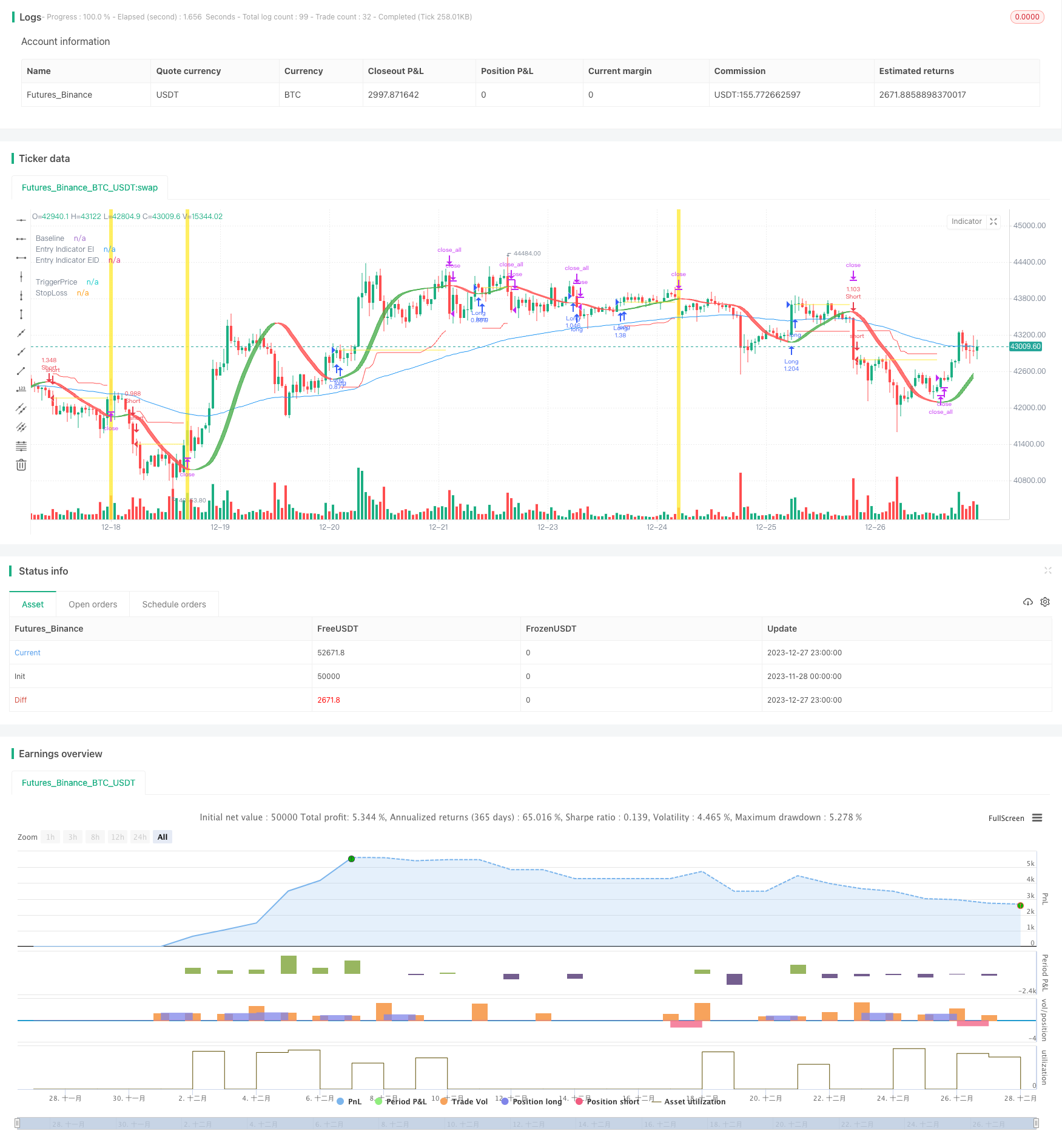
概述
均势跟踪策略运用Hull移动平均线作为主要入市指标,判断价格趋势方向。同时,该策略结合其他多种指标,如基准线、确认指标等,来验证价格趋势和过滤假信号。在入市后,策略利用平均真实波幅计算出动态止损,以跟踪趋势获利。
策略原理
均势跟踪策略的核心是Hull移动平均线。Hull移动平均线对价格变化更为敏感,可以有效判断趋势方向。当价格向上突破Hull线时,证实上涨趋势形成,做多;当价格向下跌破Hull线时,证实下跌趋势形成,做空。
此外,策略还引入了基准线指标,用于判断长短趋势;确认指标,用于过滤假突破。只有当基准线和确认指标都验证了趋势方向时,才会出发交易信号。
在入市后,策略利用ATR和 Hull EMA 计算出的平均真实波幅来设定止损位置。随着趋势的继续,止损线也会不断向上/下移位,以锁定趋势获利。
优势分析
均势跟踪策略结合趋势判断和风险控制的优点,可以在趋势行情中获得较好收益。相比固定止损策略,它可以通过移动止损来跟踪趋势运行,避免被市场正常波动止损。
许多指标的组合运用也使策略对市场变化更敏感,同时可以有效过滤假信号。此外,策略也提供了多个参数进行调整,用户可以根据自己对市场的判断进行优化。
风险分析
该策略主要依赖于趋势指标,在盘整时容易产生错误信号和止损。此外,多指标组合也可能出现指标冲突的情况。参数设置不当也会导致策略表现不佳。
可以考虑在策略中加入附加判断模块,在指标出现分歧时暂停交易;或采用投票机制,综合多个指标的判断结果。参数设置方面,可以通过回测优化方法找到最佳参数。
优化方向
均势跟踪策略可从以下几个方向进行优化:
- 增加判断模块,如波动率module,在高波动时暂停交易;
- 增加机器学习模块,利用机器学习算法判断指标权重;
- 优化指标参数,找到最佳参数组合;
- 优化移动止损算法,使止损更好地跟踪趋势;
- 加入风险管理模块,如违背止损、动态仓位调整等。
总结
均势跟踪策略总体来说是一个优秀的趋势跟踪策略。它成功地结合了趋势判断与动态止损,可以有效跟踪趋势获利。通过进一步优化,有望获得更好的策略表现。该策略为量化交易策略的构建提供了一个良好参考。
策略源码
/*backtest
start: 2023-11-28 00:00:00
end: 2023-12-28 00:00:00
period: 1h
basePeriod: 15m
exchanges: [{"eid":"Futures_Binance","currency":"BTC_USDT"}]
*/
// © Milleman
//@version=4
strategy("MilleMachine", overlay=true, default_qty_type = strategy.percent_of_equity, default_qty_value = 100, initial_capital=10000, commission_type=strategy.commission.percent, commission_value=0.06)
// Additional settings
Mode = input(title="Mode", defval="LongShort", options=["LongShort", "OnlyLong", "OnlyShort","Indicator Mode"])
UseTP = false //input(false, title="Use Take Profit?")
QuickSwitch = true //input(true, title="Quickswitch")
UseTC = true //input(true, title="Use Trendchange?")
// Risk management settings
//Spacer2 = input(false, title="======= Risk management settings =======")
Risk = input(1.0, title="% Risk",minval=0)/100
RRR = 2 //input(2,title="Risk Reward Ratio",step=0.1,minval=0,maxval=20)
SL_Mode = false // input(true, title="ON = Fixed SL / OFF = Dynamic SL (ATR)")
SL_Fix = 3 //input(3,title="StopLoss %",step=0.25, minval=0)/100
ATR = atr(14) //input(14,title="Periode ATR"))
Mul = input(2,title="ATR Multiplier",step=0.1)
xATR = ATR * Mul
SL = SL_Mode ? SL_Fix : (1 - close/(close+xATR))
// INDICATORS //////////////////////////////////////////////////////////////////////////////////////////////////////////////////////////////////////////////////////////////////////
Ind(type, src, len) =>
float result = 0
if type=="McGinley"
result := na(result[1]) ? ema(src, len) : result[1] + (src - result[1]) / (len * pow(src/result[1], 4))
if type=="HMA"
result := wma(2*wma(src, len/2)-wma(src, len), round(sqrt(len)))
if type=="EHMA"
result := ema(2*ema(src, len/2)-ema(src, len), round(sqrt(len)))
if type=="THMA"
lend = len/2
result := wma(wma(src, lend/3)*3-wma(src, lend/2)-wma(src,lend), lend)
if type=="SMA" // Simple
result := sma(src, len)
if type=="EMA" // Exponential
result := ema(src, len)
if type=="DEMA" // Double Exponential
e = ema(src, len)
result := 2 * e - ema(e, len)
if type=="TEMA" // Triple Exponential
e = ema(src, len)
result := 3 * (e - ema(e, len)) + ema(ema(e, len), len)
if type=="WMA" // Weighted
result := wma(src, len)
if type=="VWMA" // Volume Weighted
result := vwma(src, len)
if type=="SMMA" // Smoothed
w = wma(src, len)
result := (w[1] * (len - 1) + src) / len
if type == "RMA"
result := rma(src, len)
if type=="LSMA" // Least Squares
result := linreg(src, len, 0)
if type=="ALMA" // Arnaud Legoux
result := alma(src, len, 0.85, 6)
if type=="Kijun" //Kijun-sen
kijun = avg(lowest(len), highest(len))
result :=kijun
if type=="WWSA" // Welles Wilder Smoothed Moving Average
result := nz(result[1]) + (close -nz(result[1]))/len
result
// Baseline : Switch from Long to Short and vice versa
BL_Act = input(true, title="====== Activate Baseline - Switch L/S ======")
BL_type = input(title="Baseline Type", defval="McGinley", options=["McGinley","HMA","EHMA","THMA","SMA","EMA","DEMA","TEMA","WMA","VWMA","SMMA","RMA","LSMA","ALMA","Kijun","WWSA"])
BL_src = input(close, title="BL source")
BL_len = input(50, title="BL length", minval=1)
BL = Ind(BL_type,BL_src, BL_len)
// Confirmation indicator
C1_Act = input(false, title="===== Activate Confirmation indicator =====")
C1_type = input(title="C1 Entry indicator", defval="SMA", options=["McGinley","HMA","EHMA","THMA","SMA","EMA","DEMA","TEMA","WMA","VWMA","SMMA","RMA","LSMA","ALMA","Kijun","WWSA"])
C1_src = input(close, title="Source")
C1_len = input(5,title="Length", minval=1)
C1 = Ind(C1_type,C1_src,C1_len)
// Entry indicator : Hull Moving Average
Spacer5 = input(true, title="====== ENTRY indicator =======")
EI_type = input(title="EI Entry indicator", defval="HMA", options=["McGinley","HMA","EHMA","THMA","SMA","EMA","DEMA","TEMA","WMA","VWMA","SMMA","RMA","LSMA","ALMA","Kijun","WWSA"])
EI_src = input(close, title="Source")
EI_Len = input(46,title="Length", minval=1)
EI = Ind(EI_type,EI_src,EI_Len)
// Trail stop settings
TrailActivation = input(true, title="===== Activate Trailing Stop =====")
TS_type = input(title="TS Traling Stop Type", defval="EMA", options=["McGinley","HMA","EHMA","THMA","SMA","EMA","DEMA","TEMA","WMA","VWMA","SMMA","RMA","LSMA","ALMA","Kijun","WWSA"])
TrailSLScaling = 1 //input(100, title="SL Scaling", minval=0, step=5)/100
TrailingSourceLong = Ind(TS_type,low,input(5,"Smoothing Trail Long EMA", minval=1))
TrailingSourceShort = Ind(TS_type,high,input(2,"Smoothing Trail Short EMA", minval=1))
//VARIABLES MANAGEMENT
TriggerPrice = 0.0, TriggerPrice := TriggerPrice[1]
TriggerSL = 0.0, TriggerSL := TriggerSL[1]
SLPrice = 0.0, SLPrice := SLPrice[1], TPPrice = 0.0, TPPrice := TPPrice[1]
isLong = false, isLong := isLong[1], isShort = false, isShort := isShort[1]
//LOGIC
GoLong = crossover(EI,EI[1]) and (strategy.position_size == 0.0 and QuickSwitch) and (not BL_Act or BL/BL[1] > 1) and (not C1_Act or C1>C1[1]) and (Mode == "LongShort" or Mode == "OnlyLong")
GoShort = crossunder(EI,EI[1]) and (strategy.position_size == 0.0 and QuickSwitch) and (not BL_Act or BL/BL[1] < 1) and (not C1_Act or C1<C1[1]) and (Mode == "LongShort" or Mode == "OnlyShort")
ExitLong = isLong and crossunder(EI,EI[1]) and UseTC
ExitShort = isShort and crossover(EI,EI[1]) and UseTC
//FRAMEWORK
//Reset Long-Short memory
if isLong and strategy.position_size == 0.0
isLong := false
if isShort and strategy.position_size == 0.0
isShort := false
//Long
if GoLong
isLong := true, TriggerPrice := close, TriggerSL := SL
TPPrice := UseTP? TriggerPrice * (1 + (TriggerSL * RRR)) : na
SLPrice := TriggerPrice * (1-TriggerSL)
Entry_Contracts = strategy.equity * Risk / ((TriggerPrice-SLPrice)/TriggerPrice) / TriggerPrice
strategy.entry("Long", strategy.long, comment=tostring(round((TriggerSL/TriggerPrice)*1000)), qty=Entry_Contracts)
strategy.exit("TPSL","Long", limit=TPPrice, stop=SLPrice)
if isLong
NewValSL = TrailingSourceLong * (1 - (SL*TrailSLScaling))
if TrailActivation and NewValSL > SLPrice
SLPrice := NewValSL
strategy.exit("TPSL","Long", limit=TPPrice, stop=SLPrice)
if ExitLong
strategy.close_all(comment="TrendChange")
isLong := false
//Short
if GoShort
isShort := true, TriggerPrice := close, TriggerSL := SL
TPPrice := UseTP? TriggerPrice * (1 - (TriggerSL * RRR)) : na
SLPrice := TriggerPrice * (1 + TriggerSL)
Entry_Contracts = strategy.equity * Risk / ((SLPrice-TriggerPrice)/TriggerPrice) / TriggerPrice
strategy.entry("Short", strategy.short, comment=tostring(round((TriggerSL/TriggerPrice)*1000)), qty=Entry_Contracts)
strategy.exit("TPSL","Short", limit=TPPrice, stop=SLPrice)
if isShort
NewValSL = TrailingSourceShort * (1 + (SL*TrailSLScaling))
if TrailActivation and NewValSL < SLPrice
SLPrice := NewValSL
strategy.exit("TPSL","Short", limit=TPPrice, stop=SLPrice)
if ExitShort
strategy.close_all(comment="TrendChange")
isShort := false
//VISUALISATION
plot(BL_Act?BL:na, color=color.blue,title="Baseline")
plot(C1_Act?C1:na, color=color.yellow,title="confirmation Indicator")
EIColor = EI>EI[1] ? color.green : color.red
Fill_EI = plot(EI, color=EIColor, linewidth=1, transp=40, title="Entry Indicator EI")
Fill_EID = plot(EI[1], color=EIColor, linewidth=1, transp=40, title="Entry Indicator EID")
fill(Fill_EI,Fill_EID, title="EI_Fill", color=EIColor,transp=50)
plot(strategy.position_size != 0.0 and (isLong or isShort) ? TriggerPrice : na, title="TriggerPrice", color=color.yellow, style=plot.style_linebr)
plot(strategy.position_size != 0.0 and (isLong or isShort) ? TPPrice : na, title="TakeProfit", color=color.green, style=plot.style_linebr)
plot(strategy.position_size != 0.0 and (isLong or isShort) ? SLPrice : na, title="StopLoss", color=color.red, style=plot.style_linebr)
bgcolor(isLong[1] and cross(low,SLPrice) and low[1] > SLPrice and TriggerPrice>SLPrice ? color.yellow : na, transp=75, title="SL Long")
bgcolor(isShort[1] and cross(high,SLPrice) and high[1] < SLPrice and TriggerPrice<SLPrice ? color.yellow : na, transp=75, title="SL Short")